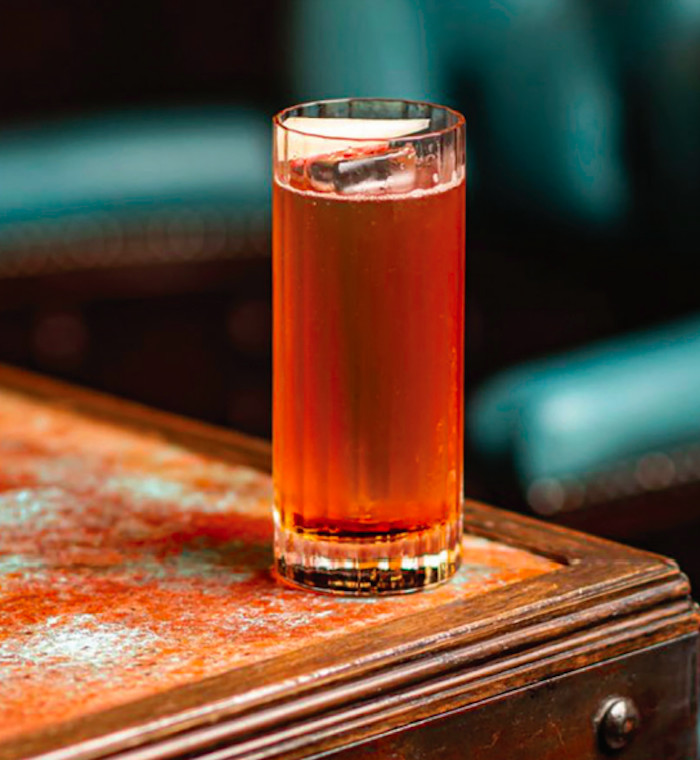
Tyler Zielinski chews the fat over the latest in umami-style cocktails.
Hate it or love it, the savoury cocktail is finally here to stay. Let’s be real, though – it’s been a long time coming. From the bone-dry Martinis garnished with blue cheese stuffed olives that proliferated throughout Midwestern American restaurants back in the ’90s, to Don Lee’s famously more refined Benton’s bacon fat-washed Old Fashioned at New York’s PDT in the late noughties, a lot of groundwork was laid down in contemporary cocktail culture’s infancy for savoury, culinary drinks.
It’s a flame that bartenders never let die, and as a result, today umami has taken its rightful place on the bartender’s flavour wheel next to bitter, sweet, sour and spice. One of the trendiest umami-rich components popping up in bars and on Instagram – what’s up, Parmesan Espresso Martini? – is cheese.
At its worst, it’s pukey, but luckily those ingredients don’t typically make their way on to menus. At its best, when properly harnessed in liquid form, cheese offers a unique mouthfeel and spectrum of flavours to a cocktail, piquing the interest of bartenders globally, and around the UK.
“Parmesan-laced Espresso Martinis aside, there’s definitely been a recent surge in cheese-based elements popping up on numerous bar menus,” says Sam Robinson, head bartender at Public in Sheffield, who stresses that cheese in a cocktail isn’t as strange as some people perceive it to be.“Bartenders working with and incorporating fats and acids into drinks is nothing new and cheese is essentially just those two elements in one convenient package.”
Where things get complicated, though, is in the manipulation of a cheese into liquid form. As many bartenders have found out through extensive research and development, there’s no one-size-fits-all method for getting the best out of a cheese, especially given the range of styles it comes in.
“Soft cheeses are great for foams and fat-washing or clarification (milk punches),” says Robinson. “Combining something like a whipped feta or even cream cheese with spirits can add creaminess, salinity and a fuller mouthfeel that works great for stirreddown drinks like a Martini.”
For the creation of Public’s Ooh Mami cocktail, Robinson and his team used the flavour profile of a blueberry cheesecake for inspiration. Vodka and amaretto are paired to mimic the typical biscuit base, a homemade blueberry shrub captures the acidic and stewed blueberry component of the cheesecake, and the cocktail is finished with a ricotta and porcini mushroom foam on top for a punch of umami and lush mouthfeel. To make the foam, Robinson blends porcini mushroom syrup with whole milk and ricotta, before straining the mixture into an iSi whipper, charging it with N2O and dispensing it into a foam.
At London’s Artesian, head bartender Giulia Cuccurullo pushes the boundaries of cheese in a cocktail by opting for the pungent blue cheese in the bar’s signature Negroni, Amo. “We wanted to play with people’s minds and preconceptions a bit,” says Cuccurullo. “So, we used the most beloved (‘amo’ means love in Latin) style of drink, a Negroni, yet we decided to incorporate some ingredients that divide opinions. In this instance, we used blue cheese that we infused into Cynar for a number of hours.”
In total, the Amo balances Campari, Glenfiddich Grand Cru 23-year-old and Artesian’s secret umami essence with the blue cheese-infused Cynar that is clarified for mixing. The result is an unctuous aperitivo cocktail that uses the cheese’s umami notes to tame the bitterness of the cocktail, yielding a delicious meal of a cocktail.
Intricacies abound
Aside from the lo-fi, trendy Parmesan Espresso Martini, which simply calls for finely grated parmesan atop the classic serve, hard cheeses are also making their way into a range of cocktails in more intricate ways.
At Project Halcyon in Manchester, assistant general manager Jake Nicholls audaciously built a cocktail around manchego cheese called the Repeal for the bar’s new menu.
“[We used] manchego cheese because of its sweet, zesty and almost savoury-meaty characteristics,” says Nicholls, who thinks about using cheese as he would any other ingredient, simply breaking the food down into its primary flavour notes. “Balancing this cheese in the cocktail was honestly a lot of trial and error, though.”
Nicholls says he experimented with an array of techniques, including fat-washing the cheese in a spirit, infusing manchego into a spirit then distilling it, and even making a tincture. Finally, he landed on a simple cold infusion into a complementary Kentucky bourbon, noting that a gentle sous vide infusion could also work if the temperature is properly controlled. Nicholls pairs the manchego-infused bourbon with Amaro Montenegro and a lactofermented strawberry soda for an umami bomb of a Whiskey Highball.
As Nicholls indicates, heat isn’t a friend to cheese as far as mixing it in cocktails is concerned. In fact, I’ve personally found this out the hard way when trying to reverse-engineer Coupette’s parmesan cordial, which featured in an umami-driven Manhattan-style cocktail called Ain’t Being Cheesy on one of the bar’s older menus.
After infusing parmesan rind with vodka, sugar and acids under sous vide at 70°C for a couple of hours, the resulting product was a vile bag of what looked and smelled like vomit. Impressive if the latter was the goal, but I quickly learned how temperamental cheeses could be.
The ideal place to start when working with hard cheeses is to ensure you don’t waste product as I did is by making use of rinds that often get thrown away. “Using rinds from hard cheeses is a great way to add umami and salinity to cocktails and infusions,” says Robinson. “After infusing you can then dehydrate the leftover solids to make crisps or tuiles, or even blend it into powders which can be used in a plethora of ways, including savoury rims, sprinkled over your favourite egg white cocktail, even a seasoning for bar snacks.”
Despite the breadth of cheesy drinks making their way on to menus around the world, it’s still early days for cheese in cocktails with plenty more for bartenders to learn. “I think that the secret of working with cheese is carefully balancing quantities and flavours – it should enhance the drink, not overpower all of the other components,” notes Cuccurullo. “Remember: less is more.”

